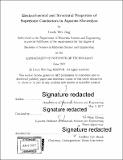Electrochemical and structural properties of superionic conductors in aqueous electrolyte
Author(s)
Jing, Linda Wei
DownloadFull printable version (8.551Mb)
Other Contributors
Massachusetts Institute of Technology. Department of Materials Science and Engineering.
Advisor
Yet-Ming Chiang.
Terms of use
Metadata
Show full item recordAbstract
The intermittent nature of renewable electricity generation has created a global need for low-cost, highly scalable energy storage. One potential solution is the low-cost air-breathing aqueous sulfur redox flow battery proposed by the Chiang group. Currently, the battery power output is significantly limited by high resistance from the membrane, a superionic conductor. This thesis investigates the electrochemical and structural properties of these superionic conductors (NaSICON and LiSICON) in aqueous electrolyte of varying pH to determine its suitability for this new battery chemistry. The membranes were characterized in acidic, neutral, and alkaline electrolytes through Electrochemical Impedance Spectroscopy (EIS), X-Ray Diffraction (XRD), and Scanning Electron Microscopy (SEM). NaSICON and LiSICON were stable in alkaline and neutral electrolytes, but unstable in acidic electrolytes. The major contribution to membrane instability in acidic electrolyte stemmed from its high interfacial area specific resistance (ASR) of 1.1 x 10³ and 9.5 x 10³ [omega]-cm² for NaSICON and LiSICON, which were 2 magnitudes above the bulk membrane ASR values of 68.6 and 101.0 [omega]-cm² all at 25°C. The high interfacial ASR were due to the incorporation of hydronium ions into the lattice structure and significant surface degradation. Twenty-four hours of exposure in acidic electrolyte resulted in micron-scaled cracks, and only a sparse network was observed after 170 hours. Based on these findings, the theoretical peak powers of the proposed flow battery are 17.1mW/cm² and 4.03mW/cm² for using NaSICON and LiSICON, respectively. For a battery with an alkaline electrolyte, NaSICON is the optimal choice. However, with an acidic electrolyte, further surface remediation methods must be explored.
Description
Thesis: S.B., Massachusetts Institute of Technology, Department of Materials Science and Engineering, 2017. Cataloged from PDF version of thesis. Includes bibliographical references (pages 49-50).
Date issued
2017Department
Massachusetts Institute of Technology. Department of Materials Science and EngineeringPublisher
Massachusetts Institute of Technology
Keywords
Materials Science and Engineering.